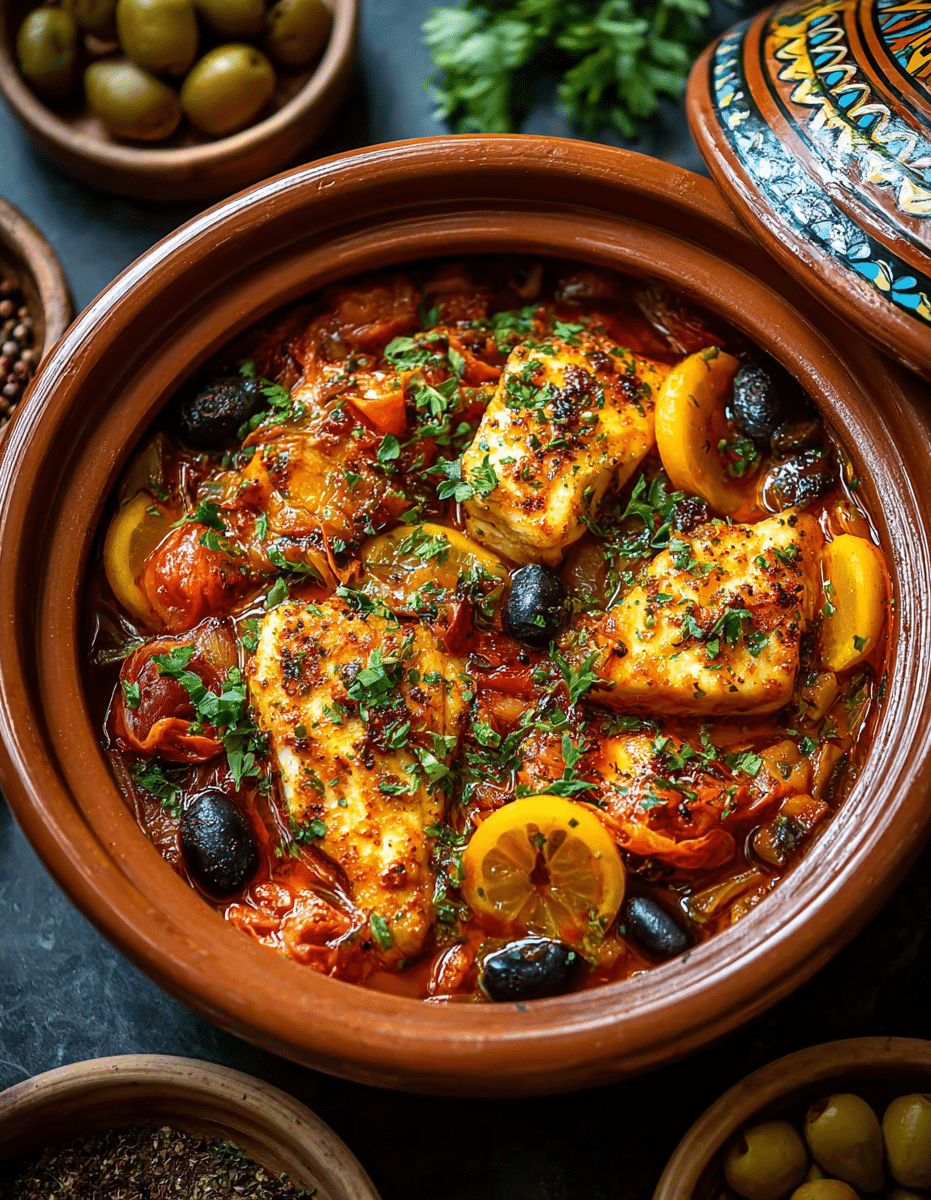This Moroccan fish tagine is a fragrant, slow-cooked stew combining chermoula-marinated white fish with layered vegetables and bold spices. Chermoula—a marinade of herbs, garlic, citrus, and warm spices—deeply flavors the fish and vegetables while tenderizing them during the long, gentle simmer. Typically cooked in a tagine pot, it can also be made in a Dutch oven or casserole. Serve it with couscous, rice, or crusty bread to soak up the aromatic sauce. It’s a show-stopper of North African cuisine—rich, colorful, and comforting.
Ingredients
Chermoula Marinade:
-
½ cup olive oil
-
½ cup chopped fresh cilantro
-
½ cup chopped fresh parsley
-
Juice of ½ lemon
-
6 garlic cloves, minced
-
1 tsp paprika
-
½ tsp ground ginger
-
½ tsp ground cumin
-
½ tsp salt
-
Optional: ¼ tsp ground saffron
Fish Tagine:
-
1½ lb firm white fish (cod, haddock, or similar), cut into pieces
-
1 Tbsp olive oil
-
1 large onion, sliced into rings
-
1 large carrot, matchsticks
-
2 potatoes, sliced thin
-
1 green bell pepper, sliced
-
3 tomatoes, seeded and cut into strips
-
¼ cup chopped cilantro
-
Optional: olives and preserved lemon for garnish
Directions
-
Marinate the fish: Mix all chermoula ingredients in a bowl. Add fish, toss to coat, cover, and refrigerate for 2 hours.
-
Prepare the vegetables: Preheat oven to 350°F (175°C).
-
Layer the base: In a tagine or Dutch oven, heat 1 Tbsp oil. Layer onion rings, carrot matchsticks, and potato slices. Top with tomato strips.
-
Add the fish: Remove fish from marinade (reserve marinade). Arrange fish over vegetables, top with bell pepper, sprinkle cilantro, and pour remaining marinade over all. Optionally add olives and preserved lemon.
-
Cook: Cover tightly. Bake for about 1 hour, until potatoes are tender and fish flakes easily.
-
Serve: Garnish with fresh cilantro (and olives or lemon slices, if desired). Serve hot with couscous, rice, or bread.
Nutrients
(Per serving; yields ~6 servings)
-
Calories: ~368 kcal
-
Total fat: 21 g
-
Carbohydrates: 22 g
-
Protein: 23 g
-
Sodium: ~289 mg
What is a Tagine?
Before delving into the details of the Moroccan Fish Tagine, it’s important to understand the cooking vessel itself—the tagine. The name “tagine” refers to both the unique cooking pot and the dish prepared within it. The traditional tagine pot is made of clay and has a distinctive conical lid that helps trap steam and moisture, ensuring a tender, slow-cooked result. This vessel is a hallmark of North African cooking and is perfect for dishes that benefit from prolonged simmering.
The beauty of a tagine lies in the slow cooking process. The steam that is trapped inside the conical lid circulates, keeping the ingredients moist and infused with each other’s flavors. While the tagine pot is the traditional choice, a Dutch oven or casserole dish can also be used effectively, as they provide a similar slow-cooking environment.
The Role of Chermoula in Moroccan Fish Tagine
One of the key components of Moroccan Fish Tagine is the chermoula marinade. Chermoula is a vibrant and aromatic mixture of fresh herbs, garlic, citrus, olive oil, and spices. It is used as a marinade for meats, seafood, and even vegetables, infusing them with rich, complex flavors. In the case of the fish tagine, the chermoula serves as both a marinade for the fish and a sauce for the entire dish.
The combination of ingredients in chermoula reflects the core of Moroccan flavor profiles: earthy cumin, warm paprika, zesty lemon, and aromatic garlic. Some variations of chermoula might also include saffron, which adds a rich, floral note to the dish. The marinade not only enhances the flavor of the fish but also helps tenderize it, allowing the spices to permeate deeply into the flesh.
The fish used in Moroccan Fish Tagine is typically a firm white fish such as cod or haddock, but other varieties can be used depending on availability. The fish absorbs the vibrant flavors of the chermoula marinade, creating a dish that’s rich in taste while remaining light and healthy. The slow cooking method ensures that the fish remains moist and tender, falling apart beautifully as it simmers in the sauce.
The Vegetables: A Colorful and Flavorful Base
Moroccan Fish Tagine is not just about the fish; the vegetables play a crucial role in the dish’s success. The layering of vegetables in the tagine pot helps create a balanced meal, with each component contributing to the overall flavor profile.
Onions, carrots, potatoes, and bell peppers are common additions, each adding a distinct texture and taste to the dish. The onions, when cooked slowly, become sweet and caramelized, forming a savory base. Carrots, sliced into matchsticks, provide a slight crunch and a touch of sweetness. Potatoes are often included to add heartiness, soaking up the flavors of the chermoula and the juices from the fish as it cooks. The bell peppers add a subtle bitterness and a pop of color, further enhancing the dish’s aesthetic appeal.
Tomatoes are often used as well, sliced into strips to form another layer of flavor and texture. As the vegetables cook, they release their juices, creating a sauce that complements the fish while keeping the dish moist. This layer of vegetables not only provides flavor but also serves as the perfect base for the delicate fish, ensuring that it cooks evenly and absorbs the aromatic sauce.
The Moroccan Spices: Warmth and Complexity
What sets Moroccan cuisine apart is the careful use of spices. Moroccan cooks are masters at balancing a variety of spices to create complex and flavorful dishes. In Moroccan Fish Tagine, spices such as paprika, cumin, and ginger form the foundation of the flavor profile. Paprika provides a smoky, earthy flavor, while cumin adds a warm, slightly nutty undertone. Ginger brings a hint of heat and freshness, balancing the other spices beautifully.
In some variations, saffron is added, elevating the dish to new heights. Saffron is a luxurious spice that adds a subtle, floral flavor and a beautiful golden hue to the tagine. While saffron is optional, it can transform the dish, adding depth and complexity to the sauce. The choice to use saffron is a nod to Morocco’s rich history in spice trade and its influence on global culinary traditions.
Cilantro is another staple herb in Moroccan cooking, and it’s used liberally in Fish Tagine. Its bright, citrusy flavor complements the other ingredients and adds a fresh finish to the dish. Some versions of Moroccan Fish Tagine may also include olives or preserved lemons as garnish, which further enhances the dish’s tangy and savory notes.
A Dish for Any Occasion
Moroccan Fish Tagine is not only a delicious meal but also a visually stunning one. The combination of bright vegetables, golden-brown fish, and vibrant green herbs creates a dish that’s as pleasing to the eye as it is to the palate. It’s the perfect dish for a family meal, a special occasion, or even a dinner party. The slow-cooked nature of the tagine means that it can be prepared in advance, allowing you to enjoy more time with guests rather than spending time in the kitchen.
When serving Moroccan Fish Tagine, it’s traditional to pair it with couscous, which soaks up the flavorful sauce and provides a light, fluffy base for the dish. Alternatively, you can serve it with rice or crusty bread to help absorb the rich, aromatic sauce. The dish’s versatility in serving options makes it adaptable to various dietary preferences and occasions.
Conclusion
In conclusion, Moroccan Fish Tagine is a perfect representation of the flavors and traditions of North African cuisine. It showcases the art of combining spices, herbs, and fresh ingredients to create a meal that is both comforting and exciting. The marriage of chermoula-marinated fish, tender vegetables, and aromatic spices creates a dish that is rich in flavor yet light and healthy. Whether you are an experienced cook or someone new to Moroccan cuisine, this dish is sure to impress with its complexity, depth of flavor, and visual appeal.
This recipe invites you to experience the boldness of Moroccan cooking in your own kitchen. The unique combination of chermoula, vegetables, and spices provides a sensory journey that will transport you straight to the heart of North Africa. So, next time you’re looking for a flavorful and satisfying meal, consider trying your hand at Moroccan Fish Tagine. With its tender fish, aromatic spices, and vibrant vegetables, it’s sure to be a showstopper at any table.






